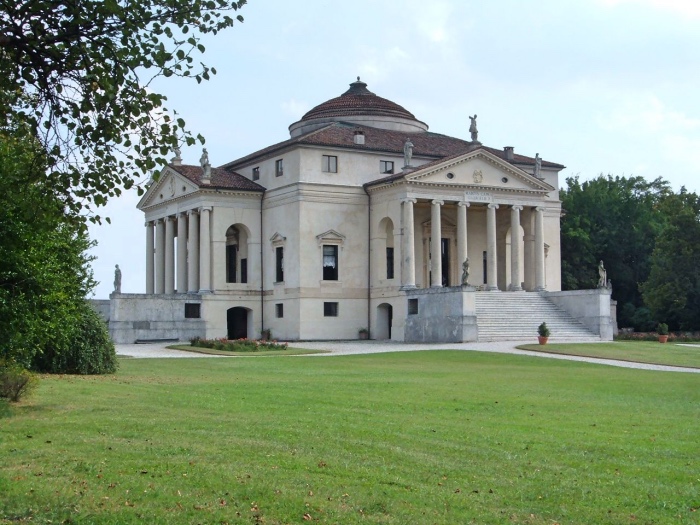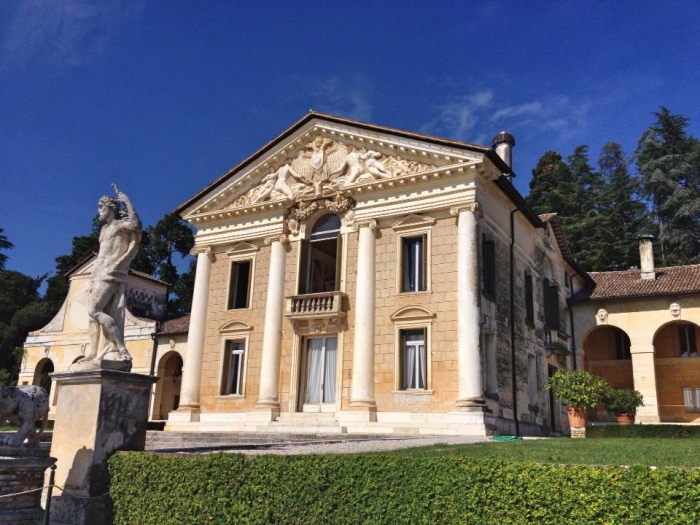
Villa Almerico Capra, detta La Rotonda (Vicenza). Image source: MoseViero.it
THE PALLADIAN VILLAS: THE VILLAS INCLUDED IN THE WORLD HERITAGE LIST
If there’s in the world an Italian architect who, more than others, was a source of inspiration to many generations, it’s certainly Andrea Palladio and the Palladian villas are very famous.
The buildings which all over the world drew inspiration from his style, and from Europe to the USA are defined “Palladian”, prove that.
READ ALSO: The Palladian wing at the Gallerie dell’Accademia.
The study of classical art and buildings of ancient Rome was the starting point for Andrea Palladio, who designed a series of villas in the territory of Vicenza, which are considered the most important masterworks in history of art and architecture.
24 Palladian villas are included in the World Heritage List.
You can’t see all of them in one day, because they are scattered in the Veneto area, but you can divide your visit into more legs, and seize the chance to make a very fascinating tour of the Veneto, seeing it through Andrea Palladio’s eyes.
In this post you’ll find the full list of the Palladian villas.
Where will you start your visit from?

Villa Foscari, detta La Malcontenta (Mira, provincia di Venezia). Image source: Venezia.Travel
Palladio was the architect of the country houses of the noble families of the Veneto in the 16th century.
However, those buildings were not pleasure residences; on the contrary, they were places of work, centres of agricultural production, surrounded by large lands, and which had to be suitable for all activities.
The Palladian Villas have two main features:
- A triangular pediment supported by pillars, and side wings;
- Suitable spaces for the production of agricultural products, social life and status of the owner.
For this reason, inside the villas the decorations were commissioned to the most important artists at that time.
THE PALLADIAN VILLAS
- Villa Almerico Capra, also known as La Rotonda (Vicenza)
- Villa Gazzotti Grimani (Vicenza, località Bertesina)
- Villa Angarano, detta anche come Villa Bianchi Michiel (Bassano del Grappa, near Vicenza)
- Villa Caldogno (Caldogno, near Vicenza)
- Villa Chiericati (Vancimuglio di Grumolo delle Abbadesse, near Vicenza)
- Villa Forni Cerato (Montecchio Precalcino, near Vicenza)
- Villa Godi (Lonedo di Lugo di Vicenza, near Vicenza)
- Villa Pisani (Bagnolo di Lonigo, near Vicenza)
- Villa Pojana (Pojana Maggiore, near Vicenza)
- Villa Saraceno (Agugliaro, near Vicenza)
- Villa Thiene (Quinto Vicentino, near Vicenza)
- Villa Trissino (Meledo di Sarego, near Vicenza)
- Villa Trissino (Vicenza, località Cricoli)
- Villa Valmarana (Lisiera di Bolzano Vicentino, near Vicenza)
- Villa Valmarana (Vigardolo di Monticello Conte Otto, near Vicenza)
- Villa Piovene (Lugo di Vicenza, near Vicenza)
- Villa Badoer, also known as La Badoera (Fratta Polesine, near Rovigo)
- Villa Barbaro (Maser, near Treviso)
- Villa Emo (Vedelago, near Treviso)
- Villa Zeno (Cessalto, near Treviso)
- Villa Foscari, detta La Malcontenta (Mira, near Venice)
- Villa Pisani (Montagnana, near Padova).
- Villa Cornaro (Piombino Dese, near Padova)
- Villa Serego (Santa Sofia di Pedemonte di San Pietro in Cariano, in Verona)
In addition to the villas, Palladio designed other buildings, erected especially in the historic centre of Vicenza, and the most important are certainly his first early work and his last project.
His first work was the enlargement of the Palazzo della Ragione in 1542, now called Basilica Palladiana (Palladian Basilica).
The last one was the Teatro Olimpico (Olympic Theatre), the first roofed permanent theatre in modern history.

Villa Barbaro (Maser, provincia di Treviso). Image source: BellAsolo.it

